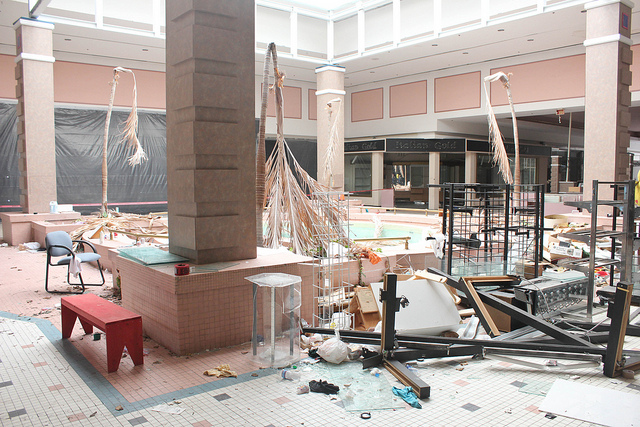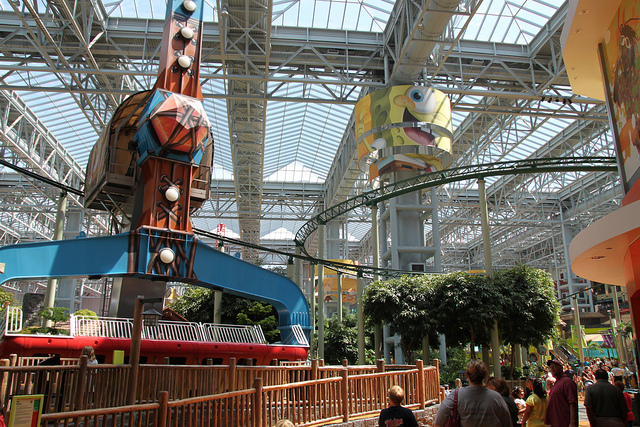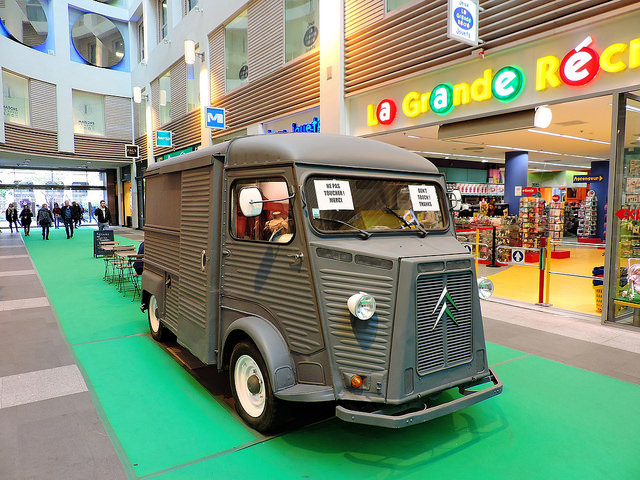Apparently, the jury’s still out.

Cloverleaf Mall, Chesterfield VA. photo by Will Fisher
One thing experts can agree upon, though: The retail landscape of the traditional shopping mall is undergoing a huge transformation, and its future is uncertain. Thanks to the arrival of the worldwide e-commerce takeover and the subsequent dip in department store sales (think recent shutdowns suffered by Macy’s and Sears Holdings), consumers no longer feel the need to head to the mall when they’re in search of specific items.
But that’s not to say customers don’t ever feel the need to travel to their local shopping centers. It just means shoppers who do visit the mall feel compelled to do so for other reasons—and its up to mall operators to capitalize on these newer, less familiar laws of retail attraction. The Internet has all but taken care of shopping for necessity and expediency. For any mall to stay afloat, it has to offer something more. As McKinsey.com noted as far back as 2014: “The e-commerce revolution and the rise of digital technologies are fundamentally reshaping consumer expectations and shifting the function of stores toward useful and entertaining customer experiences.”
And this is where good old-fashioned ingenuity comes in.
If mall landlords play their cards right, they can ride the wave of this ongoing “revolution” and come out safely and securely on the other side. Same goes for owners of standalone brick-and-mortar shops. Savvy vendors may not have the ability to change the future, but they certainly can make it look a lot less scary.
The following is an overview of some of the lessons mall operators are gleaning from the recent “shift” in current buying trends, along with some thoughts on how these lessons can translate into helpful hints for the solo retailer.
Lesson 1: Yes, and…?
Successful shopping center landlords are taking a page from a time-honored comedy improv technique and meeting business challenges with the question, “Yes, and…?” Knowing their customers are no longer content with conventional “anchor stores” surrounded by specialty in-line vendors, mall operators are upping the ante considerably and throwing new amenities into the mix, often with a dash of social media that provides a heightened enthusiasm and an added sense of community. The thinking goes like this: “Yes, of course we’ll rent space to retail stalwarts like Nordstrom and Lord and Taylor and provide audiences with the usual shopping experience they’ve come to expect…but what else can we do?”
The result is an upswing in all-in-one shopping developments that offer everything from luxury living quarters to gyms, concert venues and cinema multiplexes. These sprawling properties amount to “mixed-use environments,” Forbes.com contributor Paula Rosenblum says, adding that such complexes provide a communal space “where people can live, work, shop and play.” Standout examples include the Madrid area’s Xanadú (complete with balloon rides and ski slopes); Minnesota’s Mall of America (tricked out with a dinosaur museum, an aquarium and countless other attractions) and the M-City Monash outside Melbourne (currently in its early stages), designed to “deliver a seamless 24-hour lifestyle” that will include restaurants, a tennis court and an international hotel. Ultimately, the survival of a mall depends on how creative the mall operator is willing to be, Rosenblum observes. Shopping in and of itself can no longer serve as the main selling point—landlords need to think bigger if they want to keep their doors open.

The Mall of America lures shoppers in with its own amusement park. Photo by Tim Bartel.
What retailers can learn…
Your store may not be able to house a 93-foot slide like the one outside Florida’s Aventura Mall, but you can still apply the “yes, and…?” principle when building a standard brick-and-mortar shop. Think about what you can offer your customers beyond your products. Can you hire musicians to do monthly concerts after hours? Can you provide premiums for repeat visitors? Serve free coffee and snacks? Anything that enhances the shopping experience will bring you a step closer toward establishing a comfortable consumer base (see more tips for maintaining a physical storefront in the age of Amazon here: https://erply.com/entering-the-ring-with-amazon-3-tips-for-competing-against-a-seemingly-unbeatable-opponent/.)
Lesson 2: Keep a Number of Stores on Rotation
Moving on from the improv world to the baseball world, another teachable moment for retail conglomerate operators is the rise of the revolving storefront. Just as general managers keep their pitching staff on a healthy rotating schedule, landlords are employing a sort of retail timeshare system in which various popup shops and exclusive stores are showcased on an alternating timetable. This “switch it up” policy, McKinsey.com reflects, “[provides] customers with a sense of the unexpected and [gives] them a reason to treasure hunt.” Anchor stores are still key, the marketing authority insists, but an ever-changing cast of retail characters that’s been “planned and programmed” throughout the year may go a long way toward ushering in a torrent of consumer traffic.
Viage Mall, Brussels. Photo by Dimitris Kamaras
What retailers can learn…
Independent retailers may wish to adopt their own “starting rotation” using products rather than individual shops. As a store owner, you effectively act as the landlord for each of your sellable items, and, as such, you can decide which merchandise to prioritize and when. Bookstores, for example, tend to make conscious decisions about which books to face forward on shelves and which to display by the spine. Make it your job to rotate out your special product promotions in accordance with customer demand and taste. Keep your consumers guessing and amp up the “surprise” factor so that they’ll be excited to check out your offerings on a regular basis.
Lesson 3: Reverse the Retail Polarity
According to Forbes.com contributor Pamela N. Danziger, traditional mall operator strategies are switching gears in a major way. “[A mall landlord’s] primary job is not about real estate…[but about] transforming their business model to one focused on attracting shoppers so that they can then attract tenants, not the reverse as in the past,” Danziger says. This would seem to indicate that mall operators who want to keep their business booming now have to prove themselves worthy of precious retailer time. In theory, if landlords do some extensive field research and invest in exciting features designed to draw in target local demographics, mall operators subsequently can take away a considerable amount of risk for retailers who may be on the fence about partnering with a conventional shopping center. Put simply, the approach reads: “Get the right shoppers, sign with the right stores, bring in even more shoppers, repeat.” The Motley Fool reports this tactic is already in play in places like Long Island’s Roosevelt Field Mall, where operator Simon Property Group is tempting brands by offering them “interactive and experiential retail space” inside a customized department store that includes high-tech architectural structures like personalize-able “digital media walls.” Similarly, a shopping center in Paramus (the mall capital of New Jersey) is doing its part to curry favor with retailers on the hunt for square footage by implementing a dual babysitting/kids’ fitness program that’s sure to appeal to local soccer moms and entice parent-friendly storefronts into signing profitable leases.
What retailers can learn…
The concept of knowing your audience is a good takeaway for any retail endeavor, whether it’s a huge shopping complex or a tiny mom-and-pop affair. Catering to the intricacies of your customers’ needs and wants will keep you in good stead with your suppliers, and perhaps pique the interest of local brands hoping to make a name for themselves. As Danziger indicates, having a “deep understanding” of your immediate market can help re-shape consumer habits and establish long-lasting relationships.
Another point to keep in mind is that, should you be on the lookout for space in a shopping center, you can afford to choose wisely. Don’t just jump at the first offer you get; save yourself for a mall complex that’s employing thoughtful and innovative methods to get you the customers you require.
Remember: Malls and retail storefronts aren’t necessarily becoming extinct, but they are evolving. As a retailer, your Darwinian task is either to adapt or risk losing your place in the commercial gene pool. Survival is within reach, but you’ll have to be determined and, above all, inventive. We wish you well.